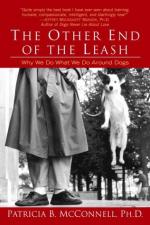
|
| Name: _________________________ | Period: ___________________ |
This test consists of 15 multiple choice questions and 5 short answer questions.
Multiple Choice Questions
1. Why is it important to ask a breeder about a dog's lineage?
(a) To get as much information about its physical traits.
(b) To get as much information about its personality.
(c) To get as much information about its ability to show.
(d) To get as much information about its monetary worth.
2. What should an owner do if the dog persists in an unwanted behavior?
(a) Turn away from the dog and avoid eye contact.
(b) Grab the dog by the collar and make eye contact.
(c) Turn towards the dog and make eye contact.
(d) Grab the dog by the scruff of the neck and avoid eye contact.
3. McConnell states that what is contrary to a dog's nature?
(a) Exercising them too much.
(b) Feeding them twice a day.
(c) Putting them in a kennel.
(d) Cooping them up all day.
4. What is the leader in a social hierarchy called?
(a) Delta.
(b) Alpha.
(c) Beta.
(d) Omega.
5. According to McConnell, do all dogs enjoy petting?
(a) Yes, especially big dogs like to be petted.
(b) No, big dogs do not like to be petted.
(c) No, some dogs do not like to be petted.
(d) Yes, all dogs like to be petted.
6. Who are the betas in a social hierarchy?
(a) They are the followers who were once leaders.
(b) The are the followers who are content with their position.
(c) They are the leaders who wish to give up their position.
(d) They are the status seekers who wish to improve their position.
7. What is the command McConnell suggests to give a dog so that it will wait at the door?
(a) Stay.
(b) Enough.
(c) Mind.
(d) Down.
8. According to McConnell, what should an owner NOT assume about petting her or his dog?
(a) That the dog wants to be petted.
(b) That others want to pet the dog.
(c) That the dog does not want to be petted.
(d) That others do not want to pet the dog.
9. Who displays affection by "ventral-ventral contact"?
(a) Dogs.
(b) Humans.
(c) Cats.
(d) No one.
10. What is the ideal way of correcting bad behavior, according to McConnell?
(a) Yelling at the bad behavior and redirecting it to a desired behavior.
(b) Waiting for the bad behavior to stop and praising the cessation of bad behavior.
(c) Interrupting the bad behavior and redirecting it to a desired behavior.
(d) Interrupting the bad behavior and punishing the bad behavior.
11. How important are physical traits in choosing a dog for McConnell?
(a) Important for men.
(b) Not important.
(c) Important for women.
(d) Very important.
12. According to McConnell, an owner should de-emphasize what as an ideal way to deal with a dog?
(a) Dominance.
(b) Submission.
(c) Treats.
(d) Commands.
13. Why does McConnell advocate for a dog to be in the right environment for its breed?
(a) Because otherwise the dog cannot be trained.
(b) Because otherwise the owners will give up on the dog.
(c) Because otherwise it is a disservice to the dog.
(d) Because otherwise it will be expensive to keep the dog.
14. What three things should an owner do to prevent a dog from leaping onto her or his lap?
(a) Get up, make eye contact, tell the dog "Stop."
(b) Body block, make eye contact, tell the dog "Stop."
(c) Get up, avert eye contact, tell the dog "No."
(d) Body block, avert eye contact, tell the dog "No."
15. According to McConnell, why is social structure NOT as important to dogs as many might think?
(a) Because dogs are not like juvenile wolves and juvenile coyotes, who have more social structure.
(b) Because dogs are like juvenile wolves, who have less social structure.
(c) Because dogs are like adult foxes, who have less social structure.
(d) Because dogs are not like wolves, coyotes, or foxes, who have more social structure.
Short Answer Questions
1. What does "ventral-ventral contact" mean?
2. According to McConnell, where do dogs not necessarily like to be petted?
3. According to McConnell, dog ______changes just like human _________.
4. Besides giving a dog a command to wait at the door, what else does McConnell suggest an owner do?
5. Who does NOT display affection by "ventral-ventral contact"
|
This section contains 681 words (approx. 3 pages at 300 words per page) |

|




